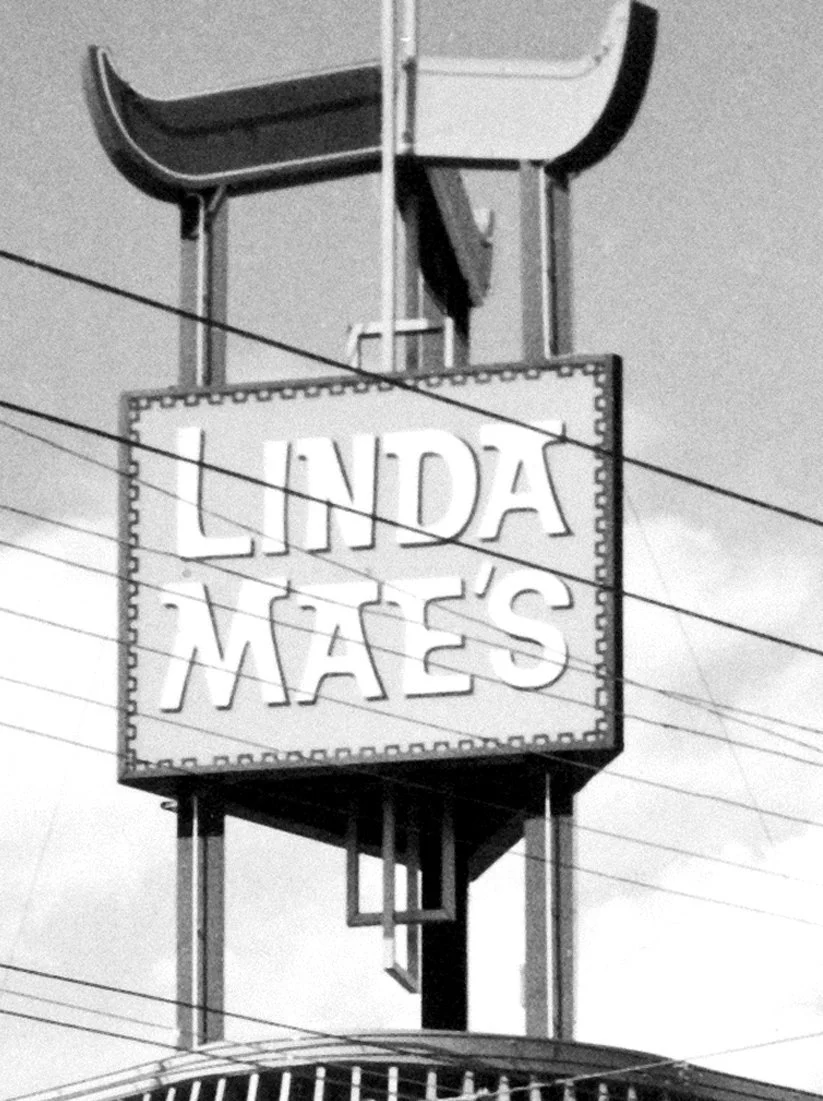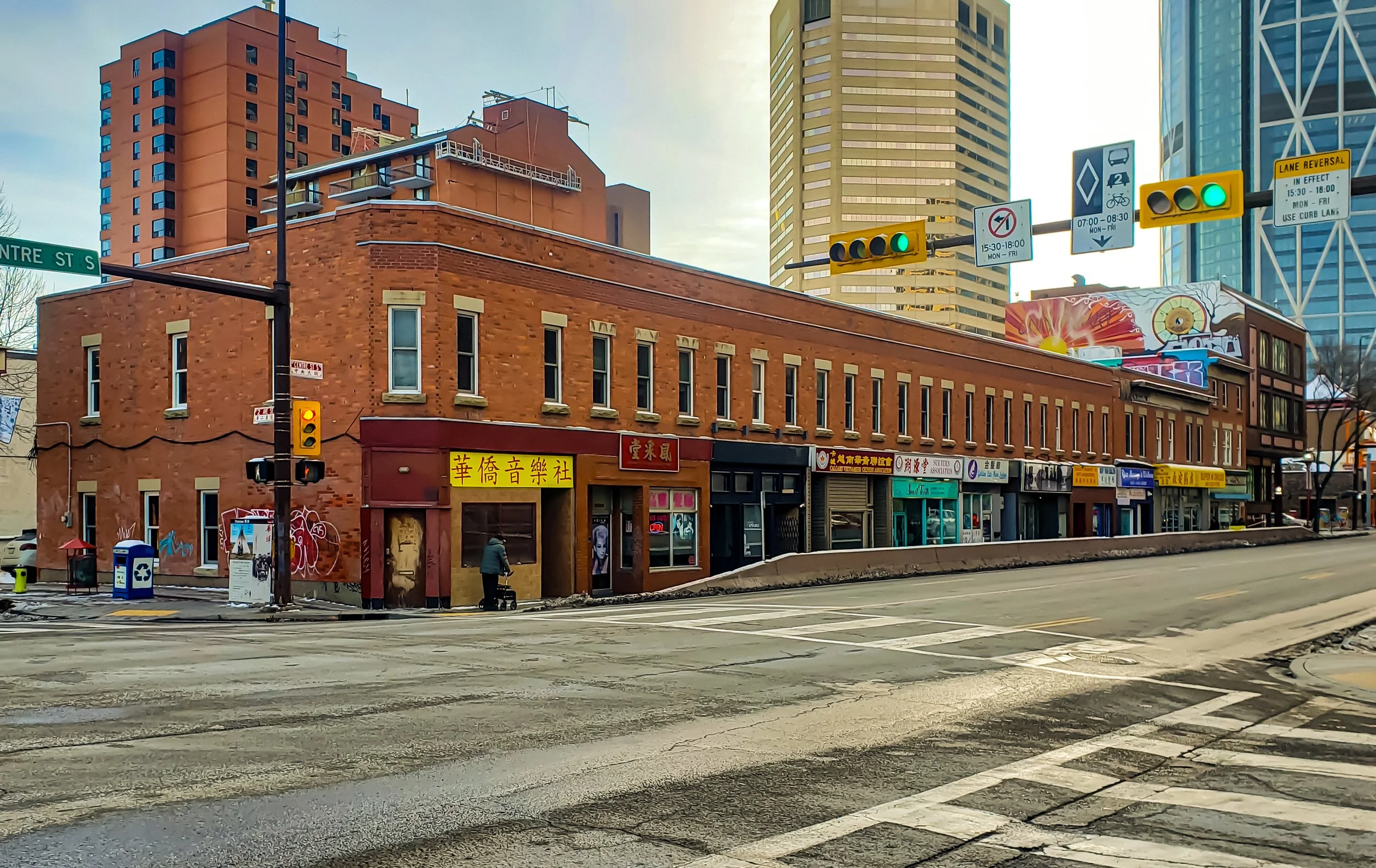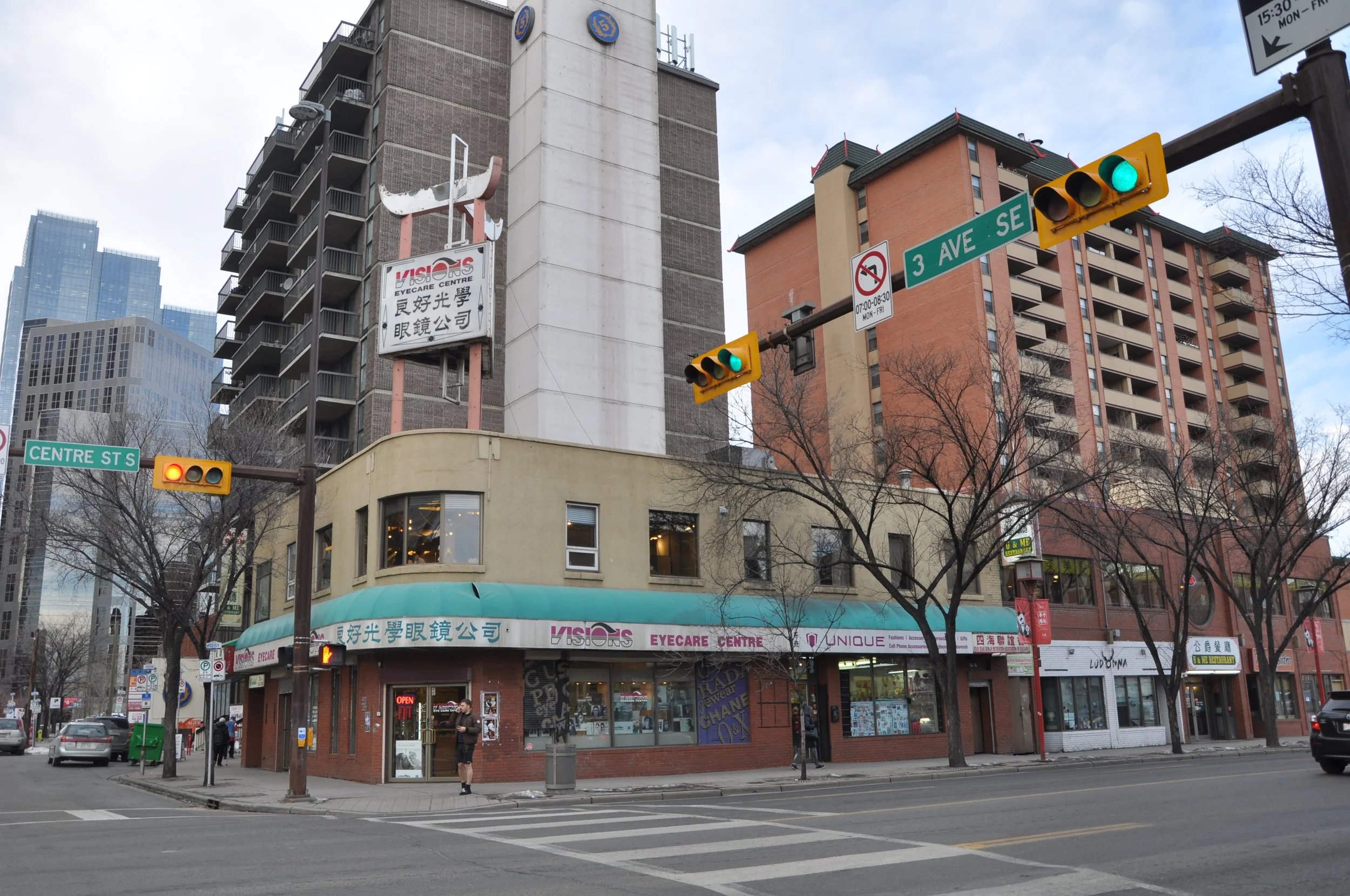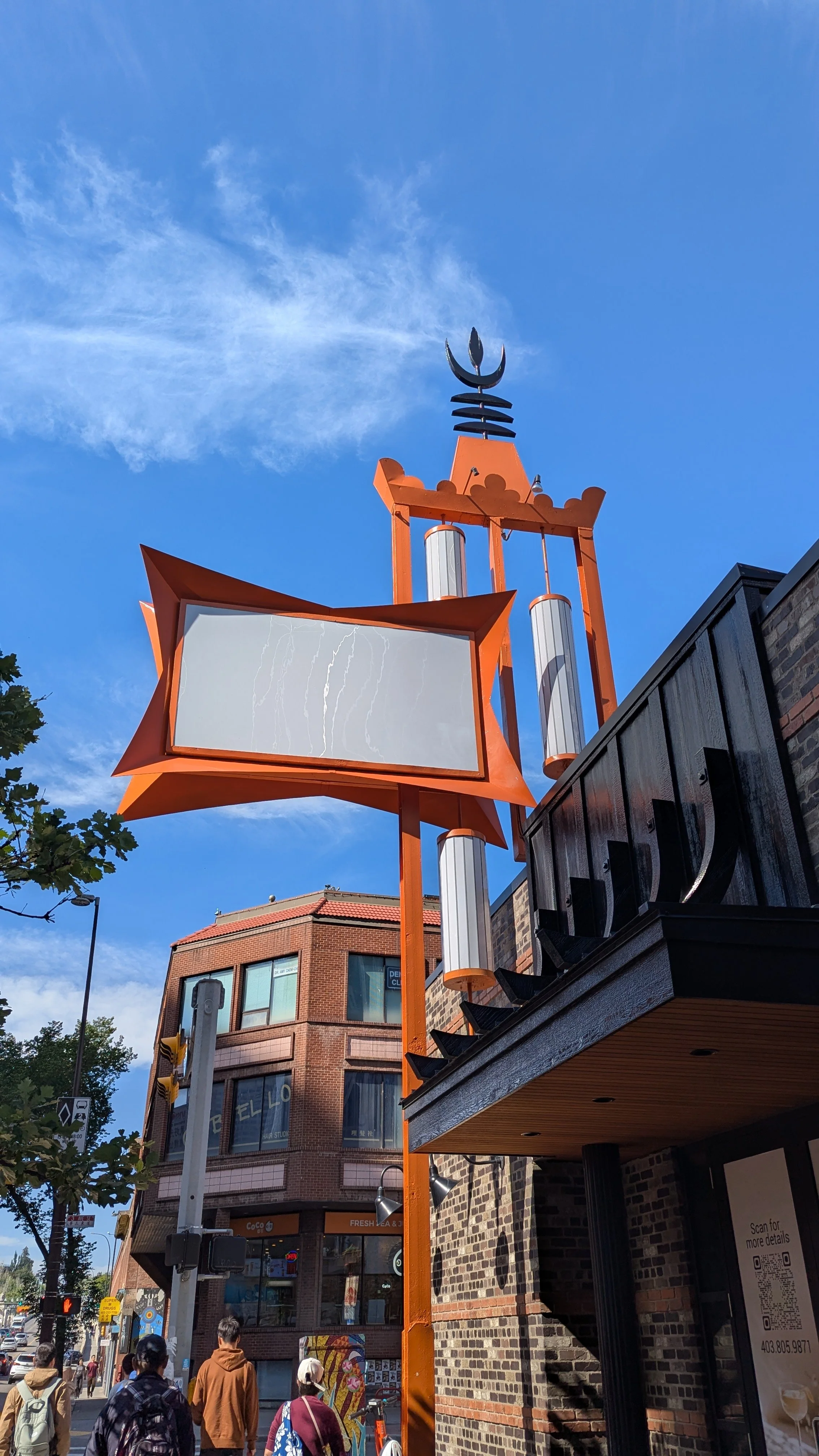Guest Blog: Signing Success - Historic Signs of Chinatown's Restauranteurs
July 15, 2025
Written by Katie Qin
Program Assistant Summer Student
Linda Mae Block, cropped photo of roof top sign (1967), Glenbow Archives na-2645-54
“We want to do honest business in Calgary, same as all men,” Chinese merchant Luey Kheong declares in a letter to the Calgary Herald 1910. This was the early days of Calgary’s Chinese community, when Luey Kheong and his peers fought for a permanent place to call home after their little group of ethnic kin were repeatedly displaced by Calgary’s growing population and industry. [i]
Luey Kheong’s leadership is memorialized in the built environment of Chinatown today. Canton Block, the row of storefronts cladded with fortuitous red brick and affirming in its rectangular massing and symmetry, was built by Kheong and fellow Chinese businessmen. [ii] It was the first Chinese-owned property in what is now a neighborhood that spans multiple blocks. Just as important to Kheong‘s legacy as the long-living Canton Block was his spirit for “honest business,” an ethos established by his generation of Chinese settlers that would last through the decades.
Photo of Canton Block, Inventory of Evaluated Historic Resources, Heritage Calgary.
Through the decades is where this article will go, to a period of Calgary Chinatown’s history less considered than its tumultuous early days, but equally vibrant. This article explores storefront signs of Calgary’s mid-century Chinese restaurants and the lives of their restauranteurs.
At the corner of Centre Street and 2nd Avenue, a tall triple-faced rooftop sign draws the eye to an otherwise inconspicuous building. Today the sign looks odd in its built environment, its height and pagoda-esque roof an elaborate contradiction to the building’s streamlined moderne style. [iii] In its heyday in the 1960s and 1970s though, that sign read “Linda Mae’s” in bold white letters against a red background. [iv] Its lucky colour red would have matched the red of a slatted crown covering the building’s second level.
Photo of the Linda Mae Block, Inventory of Evaluated Historic Resources, Heritage Calgary.
Linda Mae’s Cafe and Gift Shop were the business ventures of C.H. and Arline Poon, named after their youngest daughter. C.H Poon found a foothold in Chinatown’s restaurant trade after arriving in Calgary in 1930. Opening in the early 1950s, Linda Mae’s was his third restaurant venture.
Jade Palace restaurant was owned and operated by Roderick Mah and his wife Lillian for twenty-five years from its opening in 1960. The restaurant sign is iconically Googie, a futuristic, space-age-inspired design language popular in the mid-century. [v] Embedded in this vernacular rendition of Googie style is the influence of the Mah family’s Chinese culture. The sign was golden yellow, referencing the grandeur of imperial China (only emperors wore yellow) and the opportunities of “Gold Mountain”, the mythical land of fortune that early Chinese settlers mythologized North America as. There are also the white lanterns and a Chinese roofline pattern. [vi] These symbols of Chineseness marked Jade Palace as an enticing “exotic” choice for non-Chinese diners. They also paid homage to the Mah family’s own cultural hybridity. Roderick Mah was born in Canada but spent his formative years in China, immersed in the language and culture. [vii] Upon returning to Canada after World War II ended, Mah’s fluency in both Chinese and Western norms made him a valued relationship-builder and leader of Calgary’s Chinese community.
Photo of the Jade Palace Restaurant Sign. Katie Qin.
The first home of Jack Wong’s Silver Dragon Restaurant when it opened in 1966 was Canton Block, the steadfast symbol of the founding of Calgary’s Chinatown. As seen in historic photos, the restaurant’s sign at the Canton Block location featured two Chinese dragons perched on the sides of the main structure. [viii] In Chinese culture, dragons represented good fortune and invoked strength and protection. The signage of Silver Dragon’s current location recycles motifs from the original. There is still a dragon, free-floating under the text instead of menacingly perched. The Chinese text is bigger on this sign, while the sign itself is more imposing in its 3-dimensional rectangular massing. What stands out the most though, is the way “silver dragon restaurant” glows red with its neon lights. [ix]
Silver Dragon Restaurant. Photo by Chris Landry, Avenue Magazine. .https://www.avenuecalgary.com/best-restaurants-calgary/best-chinese-restaurants-in-calgary/
Neon signage was most popular in the 1950s and 1960s, dotting downtown streetscapes across North America. The 4 Seas Restaurant sign, despite being located far from Calgary’s downtown core, is one of the best-kept examples from this period. [x] Hong Kong immigrant Jack Chan’s decision to build his business outside of Chinatown set him apart from Calgary’s long-established Chinese families and reflected the growing expansion of Chinese businesses and settlement into previously White-dominated neighborhoods. Jack’s choice of 17th Avenue Northeast paid off; 4 Seas Restaurant enjoyed a loyal customer base in the predominantly immigrant and working-class communities of North-east Calgary until its closure in 2009. [xi]
4 Seas Restaurant’s sign is a red-sailed boat on a bright blue ocean and sky background. The words “Restaurant” and “Take Out and Delivery” are outlined in neon. The sign towers over its low-lying storefronts, at night bathing them in neon glow.
Photo of Four Seas neon sign, The Calgary Herald.
Built heritage such as these restaurant signs are potent symbols of their owners’ entrepreneurial spirit and dedication. They are windows into their intimate lives, from C.H. Poon’s love for his children to the dual East/West identities embraced by Roderick Mah. These signs are also records of change. Today, the Linda Mae Block and the Jade Palace Restaurant Sign are recorded in the Inventory of Evaluated Historic Resources. Instead of saying “Linda-Mae’s”, the three-sided sign now announces the eyecare centre that has occupied the block since 1989. Jade Palace’s sign retains its unique design but will soon advertise yet another new business. Silver Dragon remains a gem in Calgary’s food scene and the restaurant of choice for Chinese community celebrations. The International Avenue BRZ has taken responsibility for the 4 Seas Restaurant sign, which stands precariously on a commercial strip that is undergoing continued renewal.
Sources:
[i] Chinatown Context Paper, The City of Calgary, 2022.
[ii] Canton Block, Inventory of Evaluated Historic Resources, City of Calgary, accessed June 19, 2025, https://www.calgary.ca/arts-culture/heritage-sites/scripts/historic-sites.html?dhcResourceId=367.
[iii] Linda Mae Block, Inventory of Evaluated Historic Resources, City of Calgary, accessed June 19, 2025, https://www.calgary.ca/arts-culture/heritage-sites/scripts/historic-sites.html?dhcResourceId=858; Cheryl Wing-Zi Wong, “Linda Mae’s: An Architectural Past Life,” C Magazine, December 15, 2022, https://cmagazine.com/articles/linda-maes-an-architectural-past-life.
[v] Jade Palace Restaurant Sign, Inventory of Evaluated Historic Resources, City of Calgary, accessed June 19, 2025, https://www.calgary.ca/arts-culture/heritage-sites/scripts/historic-sites.html?dhcResourceId=860; Reyyan Dogan, “Googie Architecture: A Glimpse into the Futuristic 1950s-1970s Design Movement,” Parametric Architecture, March 11, 2025, https://parametric-architecture.com/what-is-googie-architecture/?srsltid=AfmBOoqIcbdgRP1EHAIwL-L_LGdNkDNJpg1SLO-zcy3JQrgqUIzO3p6r.
[vi] Alison Jackson, Jade Palace Restaurant in Chinatown, 3rd Avenue and Centre Street South, 1967, photograph, Calgary, Alberta, Canada, https://calgarypubliclibrary.contentdm.oclc.org/digital/collection/p280501coll7/id/686/.
[vii] Roderick Mah, obituary, Legacy Remembers, February 7-9, 2007, accessed June 19, 2025, https://www.legacy.com/us/obituaries/legacyremembers/roderick-mah-obituary?id=46360038.
[viii] “Students from St. Margaret’s School explore Chinatown, Calgary, Alberta.”, 1970-04-16, (CU1112775) by Calgary Herald, unknown photographer. Courtesy of Glenbow Library and Archives Collection, Libraries and Culture Resources Digital Collections, University of Calgary.
[ix] Kevin Brooker, “The Old-School Restaurants That Made Calgary,” Avenue Calgary, October 1, 2024, https://www.avenuecalgary.com/restaurants-food/dining-out/the-old-school-restaurants-that-made-calgary/.
[x] Annalise Klingbeil, “An effort is underway to save Calgary’s neon signs,” Calgary Herald, May 15, 2015, https://calgaryherald.com/news/local-news/an-effort-is-underway-to-save-calgarys-neon-signs-once-theyre-gone-theyre-gone.
[xi] “4 Seas Restaurant, Forest Lawn,” Swerve Magazine, Calgary Herald, April 10, 2009, https://ezproxy.lib.ucalgary.ca/login?qurl=https%3A%2F%2Fwww.proquest.com%2Fnewspapers%2Fapril-10-2009-page-94-119%2Fdocview%2F3182159078%2Fse-2%3Faccountid%3D9838.






